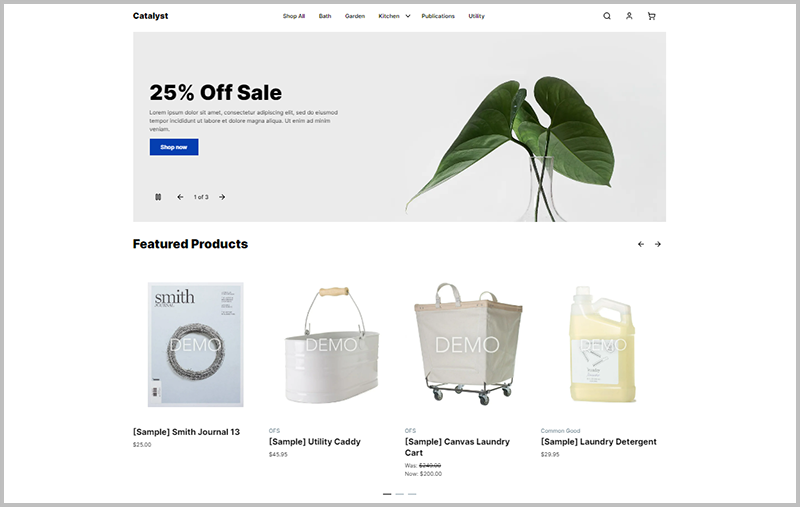Catalyst is an open-source composable storefront framework created by BigCommerce. It uses Next.js, React storefront components, and our GraphQL Storefront API to provide developers and marketers with a fully customizable storefront experience.
Catalyst comes pre-configured out of the box, giving merchants the ability to build high-performing, high-conversion storefronts quickly and easily without the complexity of code or onboarding. By providing a complete set of BigCommerce’s features as a starting point, Catalyst places a composable storefront at a higher initial jumping off point, while making it easy for developers to swap out components with third-party solutions as desired.
How Catalyst Works
Catalyst works as the presentation layer for a particular channel. You can create a fully functional storefront using our CLI and get to work in less time, without wiring up APIs or building ecommerce components from scratch. Catalyst can be deployed using Vercel, or any hosting provider that supports Node.js or Docker images.
You can find a demo version of Catalyst at https://catalyst-demo.site/, hosted on Vercel in a US region.

Requirements
- You must have a BigCommerce store (trial stores are supported).
- Catalyst requires external hosting for the Next.js frontend. You can use Vercel or any host that supports Node.js or Docker images.
- You must have multiple storefront seats in order to deploy your Catalyst storefront. See the FAQ for more information.
Learn More and Get Started
- Catalyst.dev - Learn why Catalyst should be your next headless framework. This page includes links to several useful resources, such as the GitHub repo and Catalyst developer documentation.
- Catalyst.dev/docs - Here you will find Catalyst setup, development, and deployment instructions.
- Catalyst GitHub - This is the open-source Catalyst repository on GitHub.
- Catalyst GitHub Discussions - Space for welcoming new Catalyst developers and having Catalyst-related discussions. It includes contribution guidelines, announcements, feature requests, Q&A, and more. This area is actively monitored for feedback by the BigCommerce Developer Relations and Catalyst teams.
- Catalyst Slack Channel - Slack channel for Catalyst developers. If you are not already a member of the BigCommerce developer Slack space, sign up here to join the Slack space and #catalyst channel.
- Catalyst Discord Server - Join our Discord server and the #catalyst channel for Catalyst developers.

Is Catalyst Right for Me?
If you’re not sure if your next project would be a good fit for Catalyst, ask yourself the following questions:
Are you actively looking to build a new headless storefront?
If you prefer the simplicity of having your frontend and backend management all in one place, then Stencil would be a better fit for you.
Do you have developers on staff, or are you working with a certified BigCommerce agency that provides developer services?
Some development experience will be necessary to create and deploy a new Catalyst storefront.
Are you comfortable using a third-party provider like Vercel to host your site?
Like any BigCommerce headless solution, Catalyst must be hosted externally. You can use any host that supports Node.js or Docker images, but we recommend Vercel. Most BigCommerce development and testing has been done using Vercel.
Is your storefront B2C (business-to-consumer) only?
Currently, Catalyst is optimized for B2C use cases, and support for B2B features is incomplete. It is possible to deploy a B2B experience on Catalyst, but it will require more effort in implementation. End-to-end B2B support is planned for the future.
FAQ
Does Catalyst replace Stencil?
No, Stencil remains our native storefront theme framework for non-headless stores. Catalyst and Stencil are storefront options that cater to different businesses, based on their needs.
Does Catalyst cost anything?
Catalyst is open-source for developers, and it can be used by any BigCommerce merchant with an available storefront channel, including trial stores, without incurring any additional costs from BigCommerce. However, third-party hosting for the storefront application will be an additional cost that should be considered before implementing Catalyst.
How is Catalyst related to Makeswift?
Catalyst is our composable storefront framework, while Makeswift is a visual site builder that supports composable commerce. They can be combined into a full composable experience, but you do not need a Catalyst storefront to use Makeswift, or vice versa.
Can I use Catalyst if my store has a single storefront channel?
If you have not enabled Multi-Storefront in your store, you can connect Catalyst on your default storefront channel to perform light testing, such as restyling pages. However, you cannot deploy your storefront to an external host on the default channel.
Without deploying your Catalyst storefront, you cannot configure sites and routes, which is required for a fully-functional headless storefront. For this reason, you must have a non-default storefront channel in order to use Catalyst as a live, transacting storefront channel.
If you intend on having Catalyst as your sole storefront, you can create a headless storefront and make your default storefront inactive without needing to purchase additional storefront seats. Note that this cannot be done in trial stores. For more information, see the Purchasing Storefront Seats section of Enabling Multi-Storefront.


